Fulton County Pennsylvania
Your help is requested-use this link to email~ © David W. Cathell 2006
Note!-All Links Require the Use of Your Browser's 'Back' Function
McKelvey Brothers
Blacklog Mountain-Fort Littleton
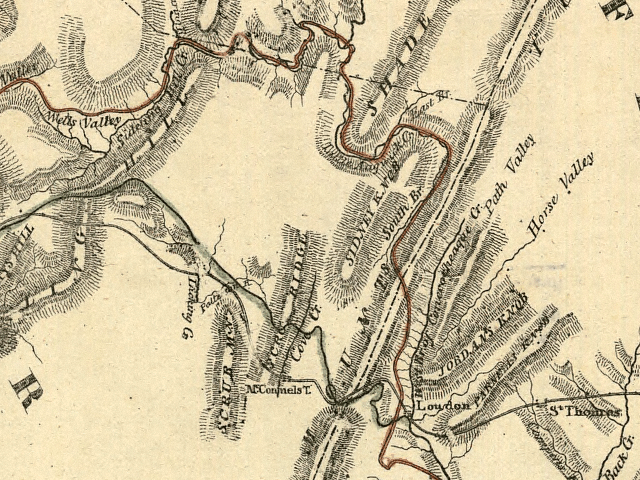
Colonel Schlatter's southern Pennsylvania route around Burnt Cabins, Fulton County Pennsylvania
Titled"Map exhibiting that portion of the State of Pennsylvania traversed by the surveys for a continuous rail road from Harrisburg to Pittsburg made under the direction of Charles L. Schlatter, c.e. in the year 1839 and 1840. Drawn by Charles Cramer."
The last logging railroad established in Fulton County was in the Little Aughwick Valley around Fort Littleton where Colonel Schlatter's proposed southern Pennsylvania rail route used the same gap created by this small stream shown on the map above.
The operators were the McKelvey Brothers who previously logged in Blair County Pennsylvania and later on the North Fork of the Potomac in West Virginia and Maryland. The McKelvey family was from Somerset County where they had become connected with the Kendalls, large logging operators, who in turn had gotten their start by working with early railroad era logger Henry Clay Huston.
Early 20th century logging was a fraternity that relied on connections to obtain timber and financing. Unlike the timber industry today, loggers needed to establish their own transportation system (the logging railroad, this area did not paricipate in the earlier river transportation system), small towns and woods camps for the workers and varying degrees of steam powered sawmill equipment. The economics of this situation required concentrated large timberlands that must be cut completely and quickly. Probably about 15 years was the decent life for a particular operation, many were shorter and a few were longer. The entire enterprise can be divided into two main industries, sawmilling (manufacturing) and logging (raw material extracting). Logging, like other extractive industries, had a unique dynamic in that the longer the operation was in existence, the more expensive it became. Even small operations like Reichley's in Fulton County's Wells Valley sometimes ended up with 30 mile railroads, every expansion meant more capital investment in rails and further unproductive haulage.
Fulton County was hampered in participating in the railroad revolution by not having raw material to haul, the bread and butter of railroads. Big timber was absent for several reasons. First, the fertile Big Cove had attracted settlers long before the Revolutionary War and the timber was cleared in that area for fields. Secondly, Fulton County is east of the Eastern Continental divide where streams more sharply erode the mountainsides (because of a relatively short distance to tidewater), leaving thinner soils and slower timber growth. Even with more erosion, there is generally less rainfall east of the divide because of the "rain shadow" effect of the higher ridges west of the divide; less rainfall also slows timber growth. Finally, timber was used before the logging railroad days by two industries, leather tanning and iron furnaces. Iron furnaces were incorporated into large estates,usually thousands of acres. The acreage was needed to supply iron ore, limestone (for flux) and coke. Iron was manufactured in areas that could supply all three of the necessary ingredients. Charcoal was the first coking agent in Pennsylvania's iron manufactory. Coke is pure carbon distilled from wood and later coal. It serves the dual function of fuel and a reducing agent, that is it removes oxides from iron ore. Charcoal was produced around iron furnaces by colliers who cut timber in manageable lengths and drug them to a cental location. Here the logs were stacked around a wooden chimney and covered with soil. The stack was lit and when well burning, the inflow of oxygen was cut off. The stack smoldered for a period of time, eventually cooking off all impurities and leaving pure carbon in the form of charcoal. This process seems wasteful in that prime sawlogs were used as well as smaller, less desirable species. Sawlogs had no real value, however, until a transportation system could be developed. Timber was used by iron furnaces aournd the Aughwick Valley, including Orbisonia's Bedford Furnace established in 1786, and was used up until about 1870. The more modern Rockhill Furnace of the 1870's was an iron furnace that used Broad Top Mountain coal as the coking agent. Coal was mined in a big way on western Broad Top Mountain after the 1850's establishment of the Pennsylvania Central and the Huntingdon and Broad Top Mountain railroads. The East Broad Top Railroad (EBT) was chartered around the same time, but was not built until the 1870's establishment of the Rockhill Iron and Coal Company (RIC) by Philadelphia and hard coal capitalists. Beside coal fields on Broad Top Mountain, RIC owned large tracts of land in the area for the narrow iron ore deposits along the base of the mountains. Because of the reasons cited above, EBT never had large timber traffic and it was not until the iron furnace was long gone did the timber on the side of Blacklog Mountain attract the attention of even a moderate size operator, in this case the McKelvey Brothers.
The McKelvey operation was headquarted in Orbisonia, Huntingdon County, the town made famous by the East Broad Top Railroad and the Rockhill Furnace. Started in 1922,the McKelvey operation seemed to have advantages over similar mine prop rail road tie operators. McKelvey's Shay locomotives were 36 inch gauge, the same as the EBT. This meant that McKelvey could interchange leased EBT flatcars at Orbisonia and let EBT personnel reload into standard gauge gondolas at Mt. Union. EBT quickly automated this process by building the Timber Transfer overhead crane that became a symbol for the railroad. Apparently, EBT also supplied rail that was surplus after EBT had spent several years upgrading their line and RIC allowed them to use derelit iron furnace buidings for various needs. It is reported that after a short switch back to boost the logging railroad up on to the side of Blacklog Mountain, the railroad had a fairly even grade with few bridges, The 21 miles of railroad was all in the timber, Finally, valuable employees including the engine crew and the sawyer had followed the McKelveys from Blair County. With the advantage of hindsight, one can say that the McKelvey's management style left something to be desired. Kline and others comment about the poor choice of power for their Orbisonia operations. They brought a 35 ton Shay from Blair County but purchased their No. 3 brand new from Lima. This Shay was a 45 ton with a superheater and cast trucks. Not only was this Shay an extravagance for such a low key operation, it was entirely too heavy for the lightly graded mainline and the even more perilous steep spurs. Many logging railroads used the 42 inch "Pennsylvania Logging Gauge" because the 36 inch narrow gauge resulted in a top heavy locomotive. Although the engineer's job was higher paying than other logging work, it was a seven day a week proposition with Sundays spent maintaining the locomotive after six days' operation. With unsuitable equipment, the derailments in the woods added another wearing job for the engine crews. Kline reports that the engineer became a familiar figure at the EBT Rockhill shops as he regularly borrowed the jacks necessary to get No. 3 back on the rails. One could say that perhaps McKelvey was looking forward to bigger things in the future when they bought No. 3, however the expensive locomotive could easily have been badly wrecked somewhere along Blacklog Mountain. One of the few photos of the McKelvey operations show the locomotive almost back on the rails after two weeks had been spent jacking it up the mountain after a "bad tumble" in March 1925.
Shortly after entering Fulton County, a branch left the mainline and descended the mountain to the Little Aughwick and then up the Plum Creek watershed. No mention is made of any freight being hauled on this logging railroad, however, if freight was hauled, the road crossing north of Ft. Littleton would be a likely unloading spot . A proposed extention of this branch towards Sideling Hill is mentioned but it never came to fruition. The McKelvey Brothers operation failed in 1928 and the assets were placed in the hands of a receiver. Ill fated No. 3 was sold to the Standard Fruit & Steamship Co. while No. 2 was retained by McKelvey's for their new company in Henry West Virginia. So ended the last logging railroad in Fulton County Pennsylvania.
Mckelvey Brother Shay No. 2 & 3
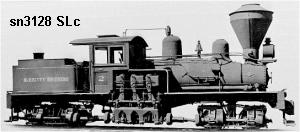
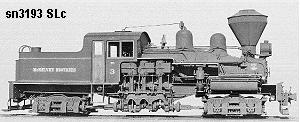
Unlike Reichley Brothers Railroad in Wells Valley, very few photos exist for McKelvey's operation at Orbisonia-below are builder photos of the Shay locomotives
No. 2 Photo Credit:
George R. Kadelak Collection
Shop Number 3128 - Built for: McKelvey Brothers Inc.
Built:
09-20-1920 Class:
B
36-2 Trucks:
2 Cylinders:
[#-Diam x Stroke]
3 - 10 x 10
Gear Ratio:
2.05 Wheel Diam:
29" Gauge:
36" Boiler:
[Style - Diam.]
E.W.T. - 39.375"
Fuel Type:
Coal Fuel Capacity:
1.75 Tons Water Capacity:
1200 Gallons Empty Weight:
As built
70,000
Owners:
McKelvey Brothers. Inc. #2, Canoe Creek, PA
McKelvey Brothers. Inc. #2, Rockhill Furnace, PA
(2-11-1928) McKelvey Forest Products,. Inc. #2, Henry, WV
(11-21-1930) Potomac Lumber Co. Inc. #2, Henry, WV
(1934) Potomac Lumber Co. Inc. #2, Shaw, WV
Disposition: (1940's) Scrapped at Shaw WV
No. 3 Photo Credit:
George R. Kadelak Collection
Shop Number 3193 - Built for: McKelvey Brothers Inc.
Built:
10-27-1922 Class:
B
50-2 Trucks:
2 Cylinders:
[#-Diam x Stroke]
3 - 11 x 12
Gear Ratio:
2.211 Wheel Diam:
32" Gauge:
36" Boiler:
[Style - Diam.]
E.W.T. - 44.25"
Fuel Type:
Coal Fuel Capacity:
3.25 Tons Water Capacity:
1750 Gallons Empty Weight:
As built
97,200
Owners:
McKelvey Brothers, Inc. #3, Orbisonia, PA
(7-1929) McKelvey Brothers, Inc. #3, Shaw, WV
McKelvey Forest Products,. Inc. #3, Henry, WV; stored, never used
E. H. Wilson & Co. (D)(?loc)
Birmingham Rail & Locomotive Co. (D), Birmingham, AL
(5-29-1931) Standard Fruit & Steamship Co. #41, La Ceiba, Honduras
(1966) For sale
Disposition: Scrapped
© 1998-2006 www.shaylocomotives.com. All Rights Reserved.
McKelvey Brothers Railroad- The Route
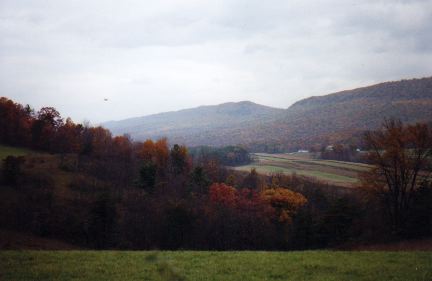 1.
1.
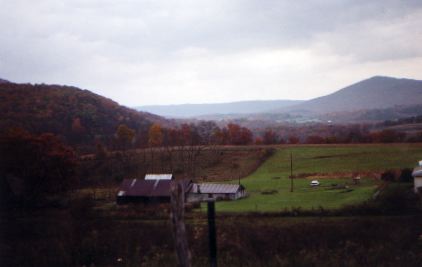 2.
2.
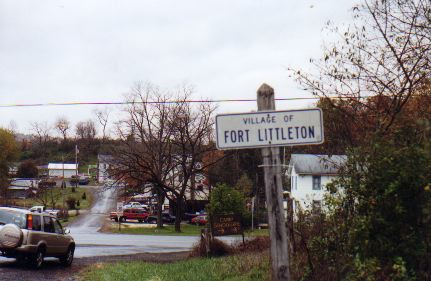 3.
3.
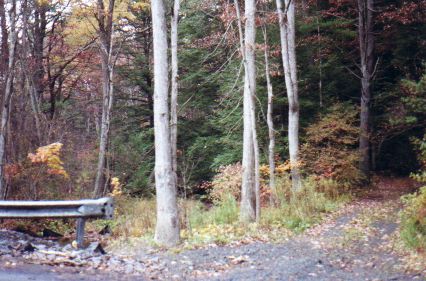 4.
4.
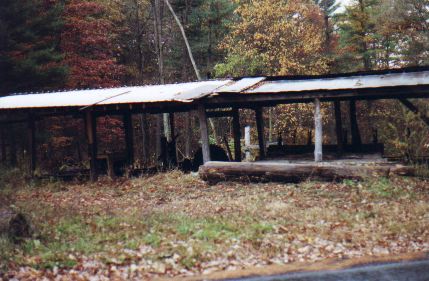 5.
5.
1.-Blacklog Mt. looking north, Orbisonia is in the far distance , 2.terminus on mountain bench above Fort Littleton, 3. village of Fort Littleton dates back to the French and Indian War. 3. Branch line along Plum Creek headed towards Hustontown 4. Local sawmill that replaced the larger mills after the large tracts of timber were harvested
McKelvey Brothers Railroad- Remaining traces along the mountain
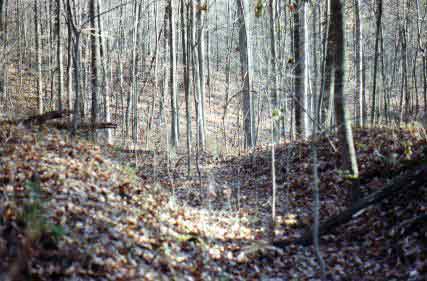 1. November 4, 2006, 80 years after the logging railroad closed, the right of way on State Game Land 81 near the Huntingdon/Fulton County line can be traced. In this photo looking south, the grade is in a cut and then curves sharply to the right.
1. November 4, 2006, 80 years after the logging railroad closed, the right of way on State Game Land 81 near the Huntingdon/Fulton County line can be traced. In this photo looking south, the grade is in a cut and then curves sharply to the right.
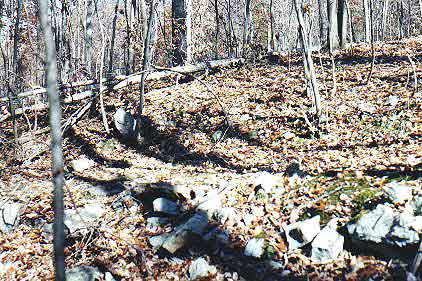 2. McKelvey's grade is marked by the large gannister stone used for ballast. Gannister is quartzite that was hauled by the EBT RR around Three Springs for use in firebrick manufature. This photo is taken below grade looking up hill.
2. McKelvey's grade is marked by the large gannister stone used for ballast. Gannister is quartzite that was hauled by the EBT RR around Three Springs for use in firebrick manufature. This photo is taken below grade looking up hill.
 3. In several location, the crunch of cinders could be felt underfoot. Because of their scattered locations, conjecture is that their occurence marks where the locomotive's ashpan was dumped or where repairs in the roadbed were needed. The photo above was taken right before the location of a tressle. Perhaps this was a log loading area, giving time for the engineer to maintain the locomotive. Or, perhaps a practice was made to dump the ashpan before crossing the wooden tressle. In the space of about 100 yards, gaps in the right of way at small hollows mark the location of low tressles, a practical expedient rather than creating a labor intensive fill.
3. In several location, the crunch of cinders could be felt underfoot. Because of their scattered locations, conjecture is that their occurence marks where the locomotive's ashpan was dumped or where repairs in the roadbed were needed. The photo above was taken right before the location of a tressle. Perhaps this was a log loading area, giving time for the engineer to maintain the locomotive. Or, perhaps a practice was made to dump the ashpan before crossing the wooden tressle. In the space of about 100 yards, gaps in the right of way at small hollows mark the location of low tressles, a practical expedient rather than creating a labor intensive fill.
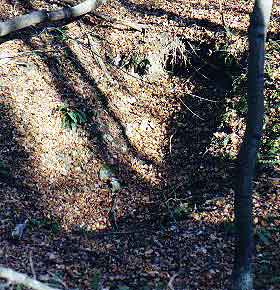 4. At a saddle between Blacklog Mountain and a ridge to the west, two rather deep excavations are found near the railroad right of way. Maybe they were the source of fill material. Or, these could be much eariler iron ore test pits.
4. At a saddle between Blacklog Mountain and a ridge to the west, two rather deep excavations are found near the railroad right of way. Maybe they were the source of fill material. Or, these could be much eariler iron ore test pits.
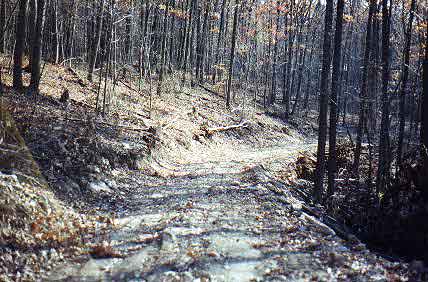 5. Above the parking lot on SGL 81, recent logging used the McKelvey railroad grade for a rough logging road. The Swope family, grandfather, father and grandsons, were squirrel hunting. The elder Mr. Swope relates that his grandfather used to tell of when the logging train came "blasting" through here.
5. Above the parking lot on SGL 81, recent logging used the McKelvey railroad grade for a rough logging road. The Swope family, grandfather, father and grandsons, were squirrel hunting. The elder Mr. Swope relates that his grandfather used to tell of when the logging train came "blasting" through here.
The grade through this area runs from about 900 to 1000 ft. elevation. The ridgetop runs from 1,750 to over 1,900 ft. elevation, so there were spurs to higher up on the ridge. Maps of today only show only the slightest of a trail in this area and the comtemporary topo maps of the time of McKelvey's operations did not mark it. Eventually the activities of man and nature will erase the last railroad in Fulton County and most will not care. But, a few will hand down the story of when the log train blasted along Blacklog Mountain.
Men Associated with McKelvey Brothers Operations on Blacklog Mountain and Plum Run, Fulton County, Pennsylvania
Frank McKelvey
Eugene Mckelvey
Frank Dickson
Roy Pritts
Simon Mitchell
Elmer Mitchell
Raymond Mitchell
William Mitchell
Elmer Mitchell
Lester Winnick
Grover Winnick
Max T. Fraker
Sam Marshall
Harry Glunt
Elmer Glunt
Harry Glunt
Rufus Lane
Howard Brown
Clair Brown
Clayton Brown
Miles Brown
Robert Ramsey
James Hanna
Phillip Locke
Cam Snyder
What Became of the McKelvey Operations?
As noted above, Frank McKelvey reorganized and moved his operations to Henry, WV where he logged Backbone Mountain in Garrett County Maryland (which was across the North Branch of the Potomac, high up in the watershed where it was a small stream). A few years later he moved the operation to Shaw WV, also on the North Branch where apparently his bad luck continued and he quit the business. He had been followed by his skilled employees, the Pritts and the Mitchells, who were left high and dry in the midst of the Depression, many miles from their homes. The Pritts took a gamble and bought the operation from the McKelvey family. After a few years, they got the company on its feet and operated the sawmill up until 1974 when the U.S. govenment took the property for Jennings Randolph Lake. Kline reports that it was the last operating sawmill from the Pennsylvania logging era. Earlier, in the 1940's, Pritts were forced to cut up Shay No. 2 and sell the scrap along with seven miles of rails to the government during a scrap drive.
Works Cited and Bibliography
Kline,Jr, Benjamin F. G.,Stemwinders in the Laurel Highland,Book No. 13 in the series Logging Railroad Era of Lumbering in Pennsylvania, self published by the author,1973, reprinted by Friends of the Railroad Museum of Pennsylvania, (c)1999
Rainey, Lee and Kyper, Frank,East Broad Top, Friends of the East Broad Top Edition, Golden West Books, San Marion, CA, 1996
Brief History of Dublin Township- Circa 1884
Logging Railroads
The South Pennsylvania Railroad
under construction
Other Fulton County Railroutes
under construction
East Broad Top Railroad Pages-use 'back' to return here
Garrett County Maryland Logging and Mining Pages-use 'back' to return here
Western Maryland Railway and Related Rail Links
Western Maryland Railway Yesterday and Today
World's Greatest Railroads!




 1.
1. 2.
2. 3.
3. 4.
4. 5.
5.



